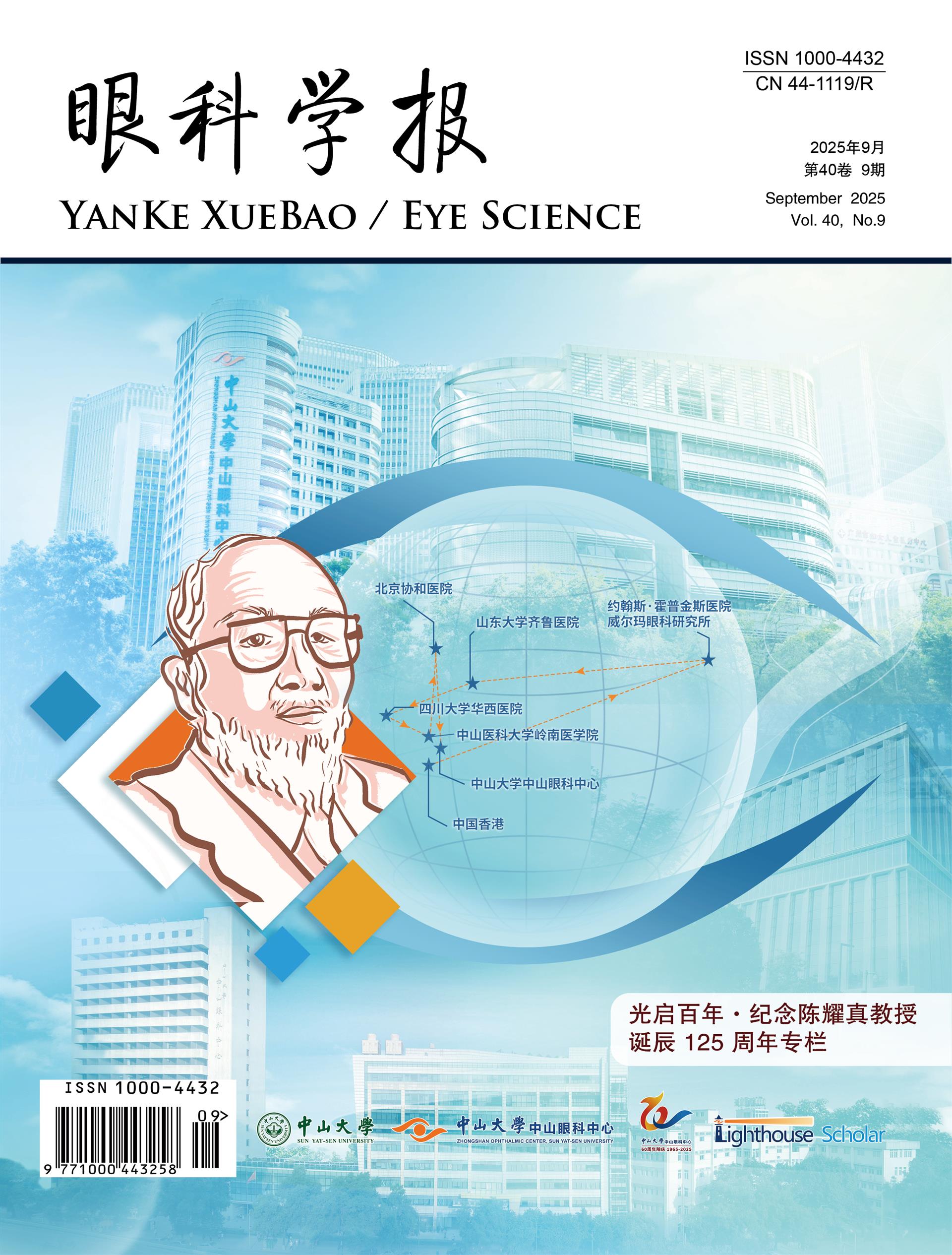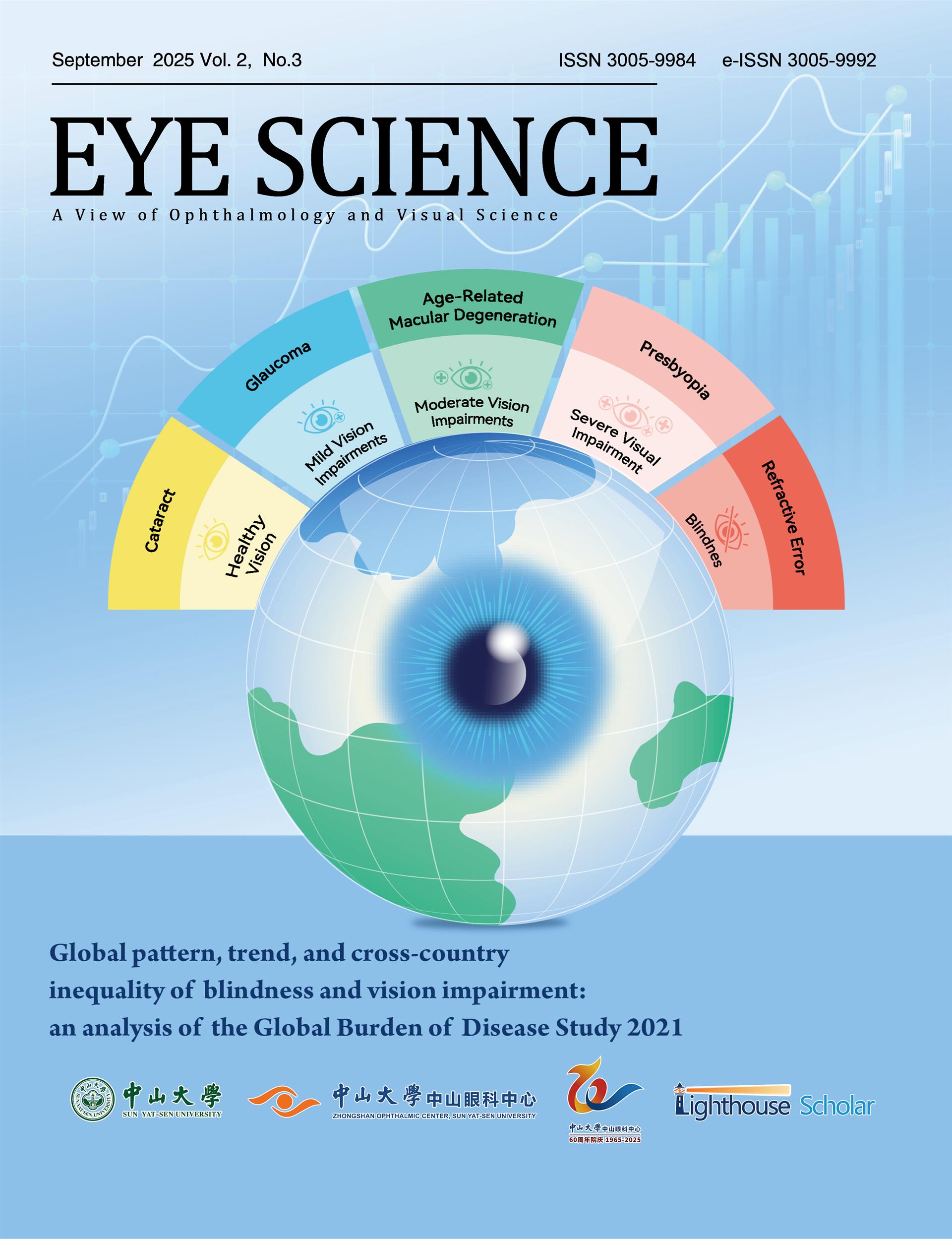1、Global, regional, and national incidence, prevalence, and years lived with disability for 354 diseases and injuries for 195 countries and territories, 1990-2017: a systematic analysis for the Global Burden of Disease Study 2017. Lancet (London, England). Nov 10 2018;392(10159):1789-1858. doi:10.1016/s0140-6736(18)32279-7Global, regional, and national incidence, prevalence, and years lived with disability for 354 diseases and injuries for 195 countries and territories, 1990-2017: a systematic analysis for the Global Burden of Disease Study 2017. Lancet (London, England). Nov 10 2018;392(10159):1789-1858. doi:10.1016/s0140-6736(18)32279-7
2、Hu C. Prevention of blindness in China. Chinese medical journal. Aug 1992;105(8):695-8.Hu C. Prevention of blindness in China. Chinese medical journal. Aug 1992;105(8):695-8.
3、Wei ZX. [The methodology and focus in blindness prevention from an epidemiologic point of view]. [Zhonghua yan ke za zhi] Chinese journal of ophthalmology. Nov 1989;25(6):365-7.Wei ZX. [The methodology and focus in blindness prevention from an epidemiologic point of view]. [Zhonghua yan ke za zhi] Chinese journal of ophthalmology. Nov 1989;25(6):365-7.
4、Zhao JL. [Prevention of blindness is still an arduous task and embarks on a long road in China]. [Zhonghua yan ke za zhi] Chinese journal of ophthalmology. Mar 2012;48(3):193-5.Zhao JL. [Prevention of blindness is still an arduous task and embarks on a long road in China]. [Zhonghua yan ke za zhi] Chinese journal of ophthalmology. Mar 2012;48(3):193-5.
5、Wei WB, Zhu RL, Yang L. Situation of low vision and blindness in China and their prevention. Chinese medical journal. Apr 2011;124(8):1123-7.Wei WB, Zhu RL, Yang L. Situation of low vision and blindness in China and their prevention. Chinese medical journal. Apr 2011;124(8):1123-7.
6、Wong IYH, Ni MY, Wong IOL, Fong N, Leung GM. Saving sight in China and beyond: the Lifeline Express model. BMJ Global Health. 2018;3(4)doi:10.1136/bmjgh-2018-000766.Wong IYH, Ni MY, Wong IOL, Fong N, Leung GM. Saving sight in China and beyond: the Lifeline Express model. BMJ Global Health. 2018;3(4)doi:10.1136/bmjgh-2018-000766.
7、Yan X, Guan C, Mueller A, et al. Outcomes and Projected Impact on Vision Restoration of the China Million Cataract Surgeries Program. Ophthalmic Epidemiology. 2013;20(5):294-300. doi:10.3109/09286586.2013.821136Yan X, Guan C, Mueller A, et al. Outcomes and Projected Impact on Vision Restoration of the China Million Cataract Surgeries Program. Ophthalmic Epidemiology. 2013;20(5):294-300. doi:10.3109/09286586.2013.821136
8、Zhao J, Xu X, Ellwein LB, et al. Prevalence of Vision Impairment in Older Adults in Rural China in 2014 and Comparisons With the 2006 China Nine-Province Survey. American Journal of Ophthalmology. 2018;185:81-93. doi:10.1016/j.ajo.2017.10.016.Zhao J, Xu X, Ellwein LB, et al. Prevalence of Vision Impairment in Older Adults in Rural China in 2014 and Comparisons With the 2006 China Nine-Province Survey. American Journal of Ophthalmology. 2018;185:81-93. doi:10.1016/j.ajo.2017.10.016.
9、Mayinuer Y, Wang NL. [Vision 2020: the progress of blindness prevention and eye health in China]. Zhonghua yi xue za zhi. Dec 29 2020;100(48):3831-3834. doi:10.3760/cma.j.cn112137-20200825-02468.Mayinuer Y, Wang NL. [Vision 2020: the progress of blindness prevention and eye health in China]. Zhonghua yi xue za zhi. Dec 29 2020;100(48):3831-3834. doi:10.3760/cma.j.cn112137-20200825-02468.
10、Zhao J, Xu X, Ellwein LB, et al. Causes of Visual Impairment and Blindness in the 2006 and 2014 Nine-Province Surveys in Rural China. American Journal of Ophthalmology. 2019;197:80-87. doi:10.1016/j.ajo.2018.09.011.Zhao J, Xu X, Ellwein LB, et al. Causes of Visual Impairment and Blindness in the 2006 and 2014 Nine-Province Surveys in Rural China. American Journal of Ophthalmology. 2019;197:80-87. doi:10.1016/j.ajo.2018.09.011.
11、Wu P-C, Huang H-M, Yu H-J, Fang P-C, Chen C-T. Epidemiology of Myopia. Asia-Pacific Journal of Ophthalmology. 2016;5(6):386-393. doi:10.1097/apo.0000000000000236.Wu P-C, Huang H-M, Yu H-J, Fang P-C, Chen C-T. Epidemiology of Myopia. Asia-Pacific Journal of Ophthalmology. 2016;5(6):386-393. doi:10.1097/apo.0000000000000236.
12、Feng JJ, An L, Wang ZF, Zhan LL, Xu X. [Analysis on ophthalmic human resource allocation and service delivery at county level in Mainland China in 2014]. [Zhonghua yan ke za zhi] Chinese journal of ophthalmology. Dec 11 2018;54(12):929-934. doi:10.3760/cma.j.issn.0412-4081.2018.12.011.Feng JJ, An L, Wang ZF, Zhan LL, Xu X. [Analysis on ophthalmic human resource allocation and service delivery at county level in Mainland China in 2014]. [Zhonghua yan ke za zhi] Chinese journal of ophthalmology. Dec 11 2018;54(12):929-934. doi:10.3760/cma.j.issn.0412-4081.2018.12.011.
13、Li J-PO, Liu H, Ting DSJ, et al. Digital technology, tele-medicine and artificial intelligence in ophthalmology: A global perspective. Progress in Retinal and Eye Research. 2021;82doi:10.1016/j.preteyeres.2020.100900.Li J-PO, Liu H, Ting DSJ, et al. Digital technology, tele-medicine and artificial intelligence in ophthalmology: A global perspective. Progress in Retinal and Eye Research. 2021;82doi:10.1016/j.preteyeres.2020.100900.
14、Nguyen HV, Tan GSW, Tapp RJ, et al. Cost-effectiveness of a National Telemedicine Diabetic Retinopathy Screening Program in Singapore. Ophthalmology. 2016;123(12):2571-2580. doi:10.1016/j.ophtha.2016.08.021.Nguyen HV, Tan GSW, Tapp RJ, et al. Cost-effectiveness of a National Telemedicine Diabetic Retinopathy Screening Program in Singapore. Ophthalmology. 2016;123(12):2571-2580. doi:10.1016/j.ophtha.2016.08.021.
15、Scotland GS, McNamee P, Fleming AD, et al. Costs and consequences of automated algorithms versus manual grading for the detection of referable diabetic retinopathy. British Journal of Ophthalmology. 2009;94(6):712-719. doi:10.1136/bjo.2008.151126.Scotland GS, McNamee P, Fleming AD, et al. Costs and consequences of automated algorithms versus manual grading for the detection of referable diabetic retinopathy. British Journal of Ophthalmology. 2009;94(6):712-719. doi:10.1136/bjo.2008.151126.
16、Newman Casey PA. Telemedicine and Diabetic Retinopathy: Review of Published Screening Programs. Journal of Endocrinology and Diabetes. 2015;2(4):01-10. doi:10.15226/2374-6890/2/4/00131.Newman Casey PA. Telemedicine and Diabetic Retinopathy: Review of Published Screening Programs. Journal of Endocrinology and Diabetes. 2015;2(4):01-10. doi:10.15226/2374-6890/2/4/00131.
17、Abràmoff MD, Lou Y, Erginay A, et al. Improved Automated Detection of Diabetic Retinopathy on a Publicly Ava ilable Dataset Through Integration of Deep Learning. Invest Ophthalmol Vis Sci. 2016/10/1/ 57(13):5200-5206. doi:10.1167/iovs.16-19964.Abràmoff MD, Lou Y, Erginay A, et al. Improved Automated Detection of Diabetic Retinopathy on a Publicly Ava ilable Dataset Through Integration of Deep Learning. Invest Ophthalmol Vis Sci. 2016/10/1/ 57(13):5200-5206. doi:10.1167/iovs.16-19964.
18、Gulshan V, Peng L, Coram M, et al. Development and Validation of a Deep Learning Algorithm for Detection of Diabetic Retinopathy in Retinal Fundus Photographs. JAMA. 2016/12/13/ 316(22):2402-2410. doi:10.1001/jama.2016.17216.Gulshan V, Peng L, Coram M, et al. Development and Validation of a Deep Learning Algorithm for Detection of Diabetic Retinopathy in Retinal Fundus Photographs. JAMA. 2016/12/13/ 316(22):2402-2410. doi:10.1001/jama.2016.17216.
19、Grassmann F, Mengelkamp J, Brandl C, et al. A Deep Learning Algorithm for Prediction of Age-Related Eye Disease St udy Severity Scale for Age-Related Macular Degeneration from Color Fun dus Photography. Ophthalmology. 2018/9// 125(9):1410-1420. doi:10.1016/j.ophtha.2018.02.037.Grassmann F, Mengelkamp J, Brandl C, et al. A Deep Learning Algorithm for Prediction of Age-Related Eye Disease St udy Severity Scale for Age-Related Macular Degeneration from Color Fun dus Photography. Ophthalmology. 2018/9// 125(9):1410-1420. doi:10.1016/j.ophtha.2018.02.037.
20、Liu H, Li L, Wormstone IM, et al. Development and Validation of a Deep Learning System to Detect Glaucom atous Optic Neuropathy Using Fundus Photographs. JAMA Ophthalmol. 2019/12/1/ 137(12):1353-1360. doi:10.1001/jamaophthalmol.2019.3501.Liu H, Li L, Wormstone IM, et al. Development and Validation of a Deep Learning System to Detect Glaucom atous Optic Neuropathy Using Fundus Photographs. JAMA Ophthalmol. 2019/12/1/ 137(12):1353-1360. doi:10.1001/jamaophthalmol.2019.3501.
21、Brown JM, Campbell JP, Beers A, et al. Automated Diagnosis of Plus Disease in Retinopathy of Prematurity Usin g Deep Convolutional Neural Networks. JAMA Ophthalmol. 2018/7/1/ 136(7):803-810. doi:10.1001/jamaophthalmol.2018.1934.Brown JM, Campbell JP, Beers A, et al. Automated Diagnosis of Plus Disease in Retinopathy of Prematurity Usin g Deep Convolutional Neural Networks. JAMA Ophthalmol. 2018/7/1/ 136(7):803-810. doi:10.1001/jamaophthalmol.2018.1934.
22、Armstrong GW, Miller JB. Telemedicine for the Diagnosis and Management of Age-Related Macular Degeneration: A Review. Journal of clinical medicine. Feb 5 2022;11(3)doi:10.3390/jcm11030835.Armstrong GW, Miller JB. Telemedicine for the Diagnosis and Management of Age-Related Macular Degeneration: A Review. Journal of clinical medicine. Feb 5 2022;11(3)doi:10.3390/jcm11030835.
23、Tsaousis KT, Empeslidis T, Konidaris VE, Kapoor B, Deane J. The concept of virtual clinics in monitoring patients with age-related macular degeneration. Acta ophthalmologica. Aug 2016;94(5):e353-5. doi:10.1111/aos.12832.Tsaousis KT, Empeslidis T, Konidaris VE, Kapoor B, Deane J. The concept of virtual clinics in monitoring patients with age-related macular degeneration. Acta ophthalmologica. Aug 2016;94(5):e353-5. doi:10.1111/aos.12832.
24、Lee YF, Chay J, Husain R, et al. Three-year Outcomes of an Expanded Asynchronous Virtual Glaucoma Clinic in Singapore. Asia-Pacific journal of ophthalmology (Philadelphia, Pa). Jul-Aug 01 2023;12(4):364-369. doi:10.1097/apo.0000000000000620.Lee YF, Chay J, Husain R, et al. Three-year Outcomes of an Expanded Asynchronous Virtual Glaucoma Clinic in Singapore. Asia-Pacific journal of ophthalmology (Philadelphia, Pa). Jul-Aug 01 2023;12(4):364-369. doi:10.1097/apo.0000000000000620.
25、Gunn PJG, Marks JR, Au L, Waterman H, Spry PGD, Harper RA. Acceptability and use of glaucoma virtual clinics in the UK: a national survey of clinical leads. BMJ open ophthalmology. 2018;3(1):e000127. doi:10.1136/bmjophth-2017-000127.Gunn PJG, Marks JR, Au L, Waterman H, Spry PGD, Harper RA. Acceptability and use of glaucoma virtual clinics in the UK: a national survey of clinical leads. BMJ open ophthalmology. 2018;3(1):e000127. doi:10.1136/bmjophth-2017-000127.
26、Mishra K, Boland MV, Woreta FA. Incorporating a virtual curriculum into ophthalmology education in the coronavirus disease-2019 era. Current opinion in ophthalmology. Sep 2020;31(5):380-385. doi:10.1097/icu.0000000000000681.Mishra K, Boland MV, Woreta FA. Incorporating a virtual curriculum into ophthalmology education in the coronavirus disease-2019 era. Current opinion in ophthalmology. Sep 2020;31(5):380-385. doi:10.1097/icu.0000000000000681.
27、Iskander M, Ogunsola T, Ramachandran R, McGowan R, Al-Aswad LA. Virtual Reality and Augmented Reality in Ophthalmology: A Contemporary Prospective. Asia-Pacific journal of ophthalmology (Philadelphia, Pa). May-Jun 01 2021;10(3):244-252. doi:10.1097/apo.0000000000000409.Iskander M, Ogunsola T, Ramachandran R, McGowan R, Al-Aswad LA. Virtual Reality and Augmented Reality in Ophthalmology: A Contemporary Prospective. Asia-Pacific journal of ophthalmology (Philadelphia, Pa). May-Jun 01 2021;10(3):244-252. doi:10.1097/apo.0000000000000409.
28、Liu H, Li R, Zhang Y, et al. Economic evaluation of combined population-based screening for multiple blindness-causing eye diseases in China: a cost-effectiveness analysis. The Lancet Global Health. 2023;11(3):e456-e465. doi:10.1016/s2214-109x(22)00554-x.Liu H, Li R, Zhang Y, et al. Economic evaluation of combined population-based screening for multiple blindness-causing eye diseases in China: a cost-effectiveness analysis. The Lancet Global Health. 2023;11(3):e456-e465. doi:10.1016/s2214-109x(22)00554-x.
29、Channa R, Iordachita I, Handa JT. Robotic Vitreoretinal Surgery. Retina (Philadelphia, Pa). Jul 2017;37(7):1220-1228. doi:10.1097/iae.0000000000001398.Channa R, Iordachita I, Handa JT. Robotic Vitreoretinal Surgery. Retina (Philadelphia, Pa). Jul 2017;37(7):1220-1228. doi:10.1097/iae.0000000000001398.
30、Savastano A, Rizzo S. A Novel Microsurgical Robot: Preliminary Feasibility Test in Ophthalmic Field. Translational vision science & technology. Aug 1 2022;11(8):13. doi:10.1167/tvst.11.8.13.Savastano A, Rizzo S. A Novel Microsurgical Robot: Preliminary Feasibility Test in Ophthalmic Field. Translational vision science & technology. Aug 1 2022;11(8):13. doi:10.1167/tvst.11.8.13.


























